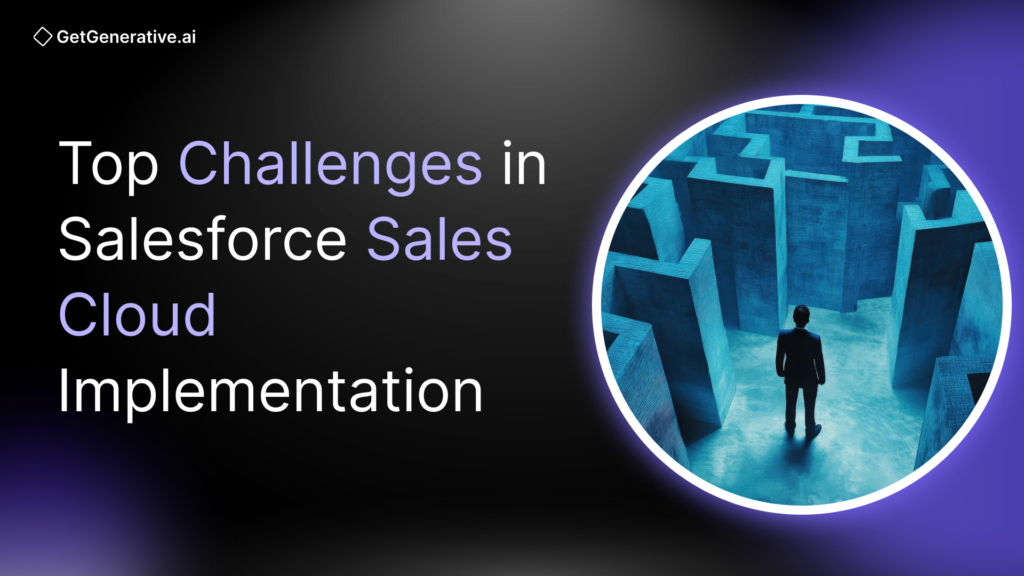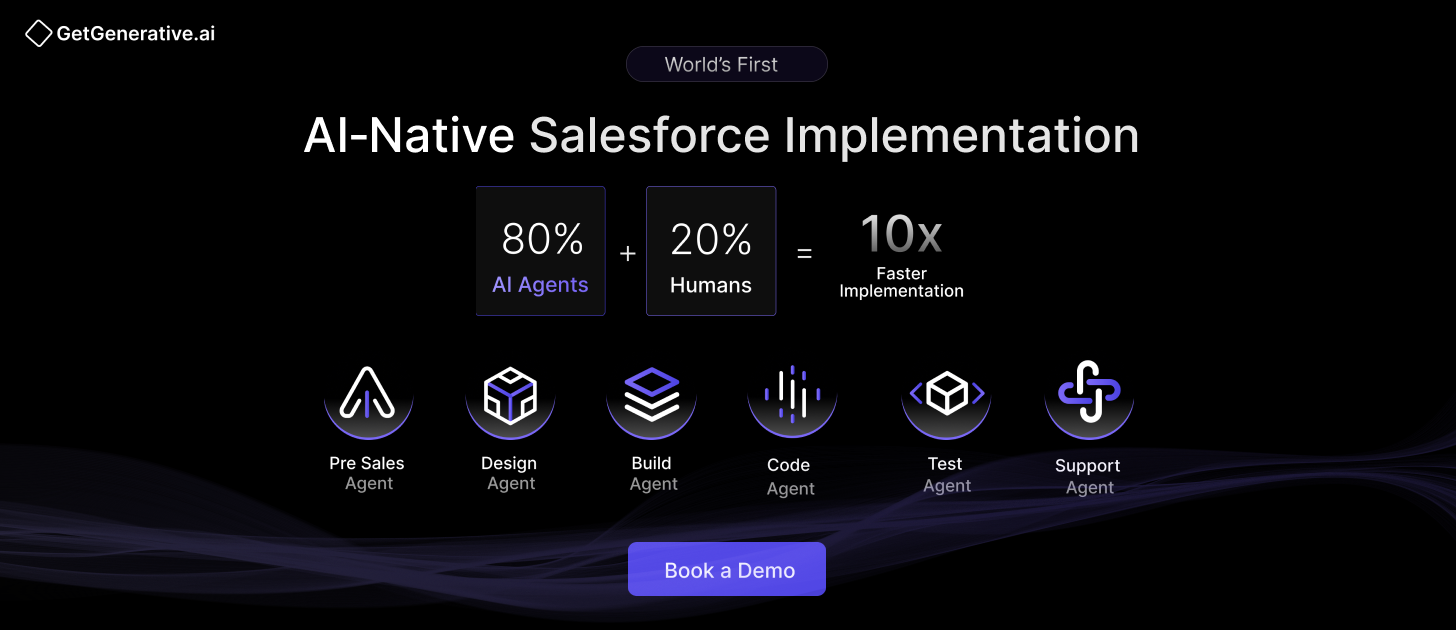Top Challenges in Salesforce Sales Cloud Implementation
Implementing Salesforce Sales Cloud is an exciting opportunity for organizations looking to enhance their sales processes, improve efficiency, and drive growth. However, as rewarding as it is, the journey of implementation comes with its fair share of obstacles. Studies have shown that up to 70% of CRM platform implementations fail, often due to common pitfalls that organizations face.
In this blog, we’ll explore the key challenges of Salesforce Sales Cloud implementation and offer actionable insights to overcome them effectively, ensuring your journey is as seamless and successful as possible.
Why Salesforce Sales Cloud Implementations Can Be Challenging
Salesforce Sales Cloud has the potential to transform the way businesses handle their sales pipelines, but achieving this level of innovation requires more than a straightforward process. Every stage, from goal setting to technical integrations, calls for thorough planning and careful execution.
Let’s dive into the most significant challenges organizations face and learn how to tackle them head-on.
1. Strategic Vision and Stakeholder Misalignment
The Challenge: No Clear Strategic Roadmap
One of the primary reasons implementations struggle is a lack of strategic clarity. Many organizations initiate their Sales Cloud deployment without fully articulating business goals, KPIs, or how the platform aligns with broader digital transformation initiatives. As a result, teams operate with fragmented expectations—sales want visibility, marketing seeks campaign automation, and leadership asks for cross-functional analytics, with no unified goalpost.
Leadership Gaps
Even when projects kick off strong, inconsistent executive commitment throughout the implementation lifecycle weakens momentum. When leadership views Salesforce as a tech upgrade instead of a business transformation tool, the initiative quickly loses strategic value.
Recommended Solutions
Set SMART goals before project kickoff
Assign a dedicated executive sponsor with defined success KPIs
Form a cross-functional steering committee to unify departmental goals
Treat change management as a cultural transformation, not just a tech project
2. Data Migration and Integration Complexities
The Challenge: Data Quality and Legacy Systems
Data migration continues to be one of the most complex, underestimated tasks in Salesforce implementations. An Experian study shows that over half of data migration projects are delayed, and just 36% stay within budget. Legacy CRMs often contain years of inconsistent schemas, duplicated entries, and outdated records, setting the stage for downstream issues.
The Challenge: Integration Architecture
Today’s enterprises depend on real-time sync between Salesforce and ERP, marketing automation, or support platforms. But without robust ETL frameworks and data governance, these integrations can cripple performance and compromise accuracy.
Recommended Solutions
Conduct a full data audit before migration
Allocate 20–25% of your implementation budget to data and integration
Use ETL tools and build repeatable, scalable pipelines
Create data governance standards and validation routines from day one
3. Change Resistance and User Adoption Barriers
The Challenge: People, Not Just Platforms
According to McKinsey, 60% of CRM projects fail due to human factors—not the software. Sales teams often view CRMs as administrative overhead, not revenue enablers. A disconnected change strategy results in slow adoption, missed opportunities, and lost ROI.
The Challenge: Ineffective Training
Salesforce data shows users typically leverage only 50% of available features. That’s not a tech problem—it’s a training gap. Generic training misses the mark, especially when it doesn’t connect workflows to real-world sales scenarios.
Recommended Solutions
Implement role-specific, scenario-based training in sandbox environments
Establish “super user” networks and peer mentoring
Use in-app help and just-in-time learning tools like Salesforce Walkthroughs
Track adoption via usage metrics, feature engagement, and support requests
4. Over-Customization and Configuration Imbalance
The Challenge: Too Much Code, Too Little Value
Salesforce’s flexibility is both its strength and a common trap. Customization often balloons project complexity, cost, and long-term maintenance. Research shows customization accounts for up to 50% of project costs, with diminishing returns if overused.
The Framework: Configure First, Customize with Intent
Configurations use Salesforce’s native tools—flows, automation, reports—while customizations involve Apex code, Visualforce, or LWC. The latter should be used sparingly and only when configuration cannot meet business needs.
Recommended Solutions
Follow a “configure first” policy with strict governance around customization
Fully document all custom objects and code
Periodically review technical debt and refactor where needed
Avoid one-off customizations that reduce upgradability or scalability
Also Read – Tips for Successful Salesforce Sales Cloud Implementation
5. Budget Overruns and Resource Misallocation
The Challenge: Hidden Costs and Misjudged Timelines
Implementation costs range widely—from $10K to over $200K, depending on project size. Scope creep, unplanned integrations, and underestimated data efforts frequently lead to budget overruns. A Forrester report noted 41% of migration projects exceeded budget.
The Challenge: Limited Internal Expertise
Without certified Salesforce admins, architects, or developers, many firms depend entirely on external partners, driving up costs and reducing internal ownership.
Recommended Solutions
Develop a comprehensive, phased budget witha buffer for contingencies
Build internal capabilities through Salesforce certification and training
Use a phased rollout model to manage cost and complexity
Track hours and resource allocation against defined project milestones
6. Compliance, Security, and Governance Gaps
The Challenge: Data Privacy and Regulatory Compliance
From HIPAA to GDPR to SOX, different industries impose stringent compliance requirements. Yet many firms overlook security and audit frameworks until late in the implementation.
The Risk: Data Breaches and Legal Exposure
Without strong data governance—covering access controls, audit logs, and field-level security—organizations expose themselves to reputational and financial risk.
Recommended Solutions
Define data classification, access levels, and retention policies early
Use Salesforce’s native security controls (encryption, MFA, audit trails)
Involve legal and compliance stakeholders in planning stages
Conduct regular permission audits and vulnerability scans
7. Platform Evolution and Release Management
The Challenge: Constant Change
Salesforce delivers three major updates per year. Each release can affect integrations, flows, and reports, introducing risk if not properly managed.
The Cost: Technical Debt
Over time, unoptimized workflows, redundant code, and deprecated features accumulate, creating technical debt that reduces agility and increases support costs.
Recommended Solutions
Create a formal release management process with sandbox testing
Monitor Salesforce release notes and join pilot programs when possible
Build rollback strategies to recover from issues
Regularly refactor and sunset outdated functionality
8. Performance and Scalability Issues
The Challenge: System Degradation at Scale
As your Salesforce org grows, performance bottlenecks can emerge, from slow page loads to report lags and governor limit errors. This leads to frustration and decreased adoption.
The Enterprise Requirement: Scale Smart
Scalability requires forward-looking architecture decisions: data modeling, API usage, query optimization, and caching patterns.
Recommended Solutions
Monitor org performance from Day 1 using Salesforce Optimizer and logs
Design scalable data models and avoid unnecessary lookups or large joins
Apply query indexing, caching, and bulk data handling best practices
Design with Salesforce governor limits in mind for future growth
Also Read – Salesforce Sales Cloud Implementation Template
Conclusion
By addressing these challenges head-on—whether it’s setting a clear vision, managing change, or ensuring data quality—you can unlock Salesforce’s full potential and drive lasting success. Remember, preparation, collaboration, and continuous improvement are the keys to a seamless Salesforce journey.
At GetGenerative.ai, we don’t just add AI to legacy processes—we’ve engineered a fully AI-native Salesforce implementation model from the ground up.
The result? Faster deployments, smarter solutions, and real business impact delivered at speed.
👉 Explore our Salesforce AI consulting services
FAQs
1. Why do many Salesforce implementations fail?
Poor planning, unclear objectives, and resistance to change are some of the most common reasons implementations fail.
2. How can user adoption of Salesforce Sales Cloud be guaranteed?
Offer specialized training tailored to specific roles, simplify processes to make workflows more intuitive, and actively engage employees in the implementation journey from the outset.
3. What is the role of a Salesforce implementation partner?
A qualified implementation partner provides the expertise needed to customize Salesforce effectively while ensuring the project aligns with your broader business goals and delivers measurable results.
4. How do I avoid data migration issues during implementation?
Conduct a thorough data audit, use data migration tools, and involve experts to ensure accuracy and consistency.
5. What steps should I take to manage scope creep?
Develop a clear implementation roadmap, monitor progress regularly, and establish strict project boundaries to stay on track.




